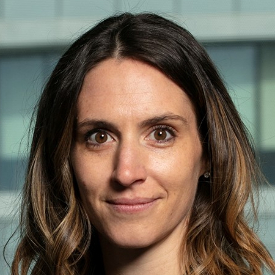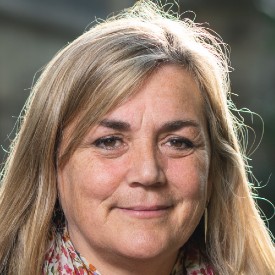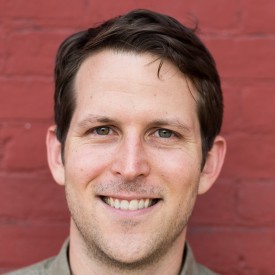For over three decades, Caroline Adams Miller has been a pioneer with her groundbreaking work in the science of goal setting, grit, happiness, and success. She is the author of numerous books, including Creating Your Best Life, the first evidence-based mass-market guide to goal setting that combined the science of success with the science of well-being.
What’s the big idea?
Big Goals explores effective goal-setting practices for personal growth and corporate success, equipping readers of all ages with the confidence and skills to achieve their ambitions. It offers a deep dive into the science of goal setting, presenting practical tools and unique worksheets to support readers on their journey. Drawing on decades of groundbreaking research in positive psychology and Caroline Adams Miller’s experience as an executive coach, the insights are both inspiring and actionable.
Below, Caroline shares five key insights from her new book, Big Goals: The Science of Setting Them, Achieving Them, and Creating Your Best Life. Listen to the audio version—read by Caroline herself—in the Next Big Idea App.

1. The goal-setting secret everyone should know.
Goal Setting Theory, published by Edwin Locke and Gary Latham in 1990, is one of the most scientifically validated and replicated approaches to achieving success, ranked number one among 73 important management theories. Yet, it remains largely unknown outside of academic circles, despite the fact that every company sets goals. Most people also rely on ineffective goal-setting approaches without scientific support, such as “SMART” goals or the Law of Attraction.
So, imagine my surprise when Goal Setting Theory was one of the first assignments I received when I returned to school in 2005 to get a master’s in applied positive psychology at the University of Pennsylvania. “There’s a thing called goal-setting theory?” I said out loud in wonderment. I went home and looked at every goal-setting book I owned, by people like Brian Tracy, Zig Ziglar, and John Maxwell, and they were all filled with urban legends and no science. I threw them all out.
Locke and Latham spent decades conducting rigorous research, first individually and then together, in both laboratories and real-world settings, rather than pursuing fame, corporate engagements, and media opportunities. Their straightforward, elegant theory offers a framework for understanding how two types of goals—performance goals and learning goals—affect our motivation and success. They discovered that both types of goals yield their best outcomes when described as “challenging and specific.”
Despite its proven effectiveness, Goal Setting Theory is known and used by fewer than 5 percent of the people I’ve ever encountered. And it’s rarely if ever, used in fancy productivity dashboards. So why does it matter to know goal-setting theory, especially right now?
Well, the Gallup Organization’s 2024 State of the Workplace Report urgently called for companies to make setting better goals their number one priority so that workers could have greater role clarity, improved productivity, and increased engagement. I believe that if more people learned, understood, and applied the principles of goal-setting theory, we could see dramatic improvements in personal and organizational performance across society, because this lack of popular awareness represents a major missed opportunity to enhance human achievement and well-being, something we should all be focused on right now for the good of the world.
2. Women’s goal penalty box.
There’s increasing awareness that men and women respond differently to events and conditions in life, including stress, happiness, sleep, and heart attacks. But it never occurred to me until recently that traditionally accepted goal-setting systems, starting with time and motion studies in the 1880s, and that are embedded in organizations all over the world, are designed to reward men and penalize women, something Stanford sociologist Cecilia Ridgeway says has created structural goal setting inequalities that are designed to keep women from power.
My eureka moment occurred a few years ago after a day of listening to popular podcasts devoted to success and productivity. After looking at my notes, I realized that all I heard were men talking to men about men, using examples like special forces heroes and historical figures to explain leadership and genius. What I didn’t hear were women being spoken of as exemplars of business success or paragons of courage, which was odd, given that women compose more than 50 percent of podcast listeners.
So, I wondered: What are these inequalities doing to women’s goal-setting aspirations and accomplishments? Were we all being primed to shoot lower and achieve less by hearing or seeing fewer inspiring stories of successful women and being surrounded by outdated gender stereotypes, like the 1990s Barbie doll that exclaimed, “Math class is tough!”
“The social, emotional, and financial penalties women face when they have big goals and act with agency are both subtle and severe.”
The more I researched, the more I found disparities that conspire to keep women from succeeding in their goals. One major meta-analysis of perceptions of women in the workplace from 1940 to the present found that although women are now perceived as more competent than before, they’ve not made any progress in the area of agency, which is goal-directed behavior that is associated with leadership and power.
The social, emotional, and financial penalties women face when they have big goals and act with agency are both subtle and severe. Consider this: Women who attend happy hours and company networking events as new hires are penalized as self-centered, but men are rewarded for it. High-performing women receive negative feedback at a much higher rate, 76 percent, compared to high-performing men, 2 percent. And women’s contributions in many academic and professional settings are routinely discounted and devalued, leading to fewer promotions and opportunities to advance their careers.
Female CEOs are given less time to succeed in their roles than men. And any female CEO who comes after a failed female CEO starts with a negative assessment of her worth—while this never happens for men who are given more time to succeed. Even worse, one recent study found that women who finished their job assignments on time are compared unfavorably with men who have the same work but who take more time and work longer hours. They’re viewed as more dedicated to the company.
Goal Setting Theory states that one moderator of successful goal pursuit is receiving neutral, unbiased feedback that indicates whether you are making progress or need to pivot. However, without the ability to rely on this type of neutral, accurate feedback, women’s goal pursuit can easily be manipulated and derailed.
And to make matters even worse, McKinsey’s 2023 Women in the Workplace report, conducted with LeanIn.org, found that women often fail to support other women’s goal accomplishment for a multitude of reasons, including fear of backlash and their own negative feelings about acting against female stereotypes, leaving agentic women feeling uncertain, undervalued, and alone.
My big conclusion: We have to scrutinize every step we take when crafting success strategies. And that starts with brainstorming, where you must carefully assess whether or not the traditional approaches to accomplishing your goal will even work for people who look and sound like you, instead of blindly following the popular prescriptions that have always existed without enough scrutiny and that are deeply embedded in organizations and life in ways that we’re only just now realizing.
3. The black swan’s gift.
When the coronavirus pandemic swept across the globe in early 2020, it delivered what Nassim Taleb calls a “Black Swan” event—an unpredictable occurrence that dramatically reshaped our world. Like a massive wave that forever altered the shoreline, COVID-19 transformed everything from how we work and learn to how we shop and connect.
In the face of such seismic change, we faced two choices: resist the transformation or embrace it as an opportunity to grow. The science of goal setting offers us wisdom through what researchers Edwin Locke and Gary Latham call “learning goals”—objectives focused on acquiring new skills and knowledge rather than just achieving specific outcomes.
The Black Death of the Middle Ages offers a compelling parallel to what we are experiencing now. That devastating pandemic wiped out one-third of Europe’s population but also catalyzed the Renaissance, spurring innovations in medicine, science, and social structures that shaped modern civilization.
“Resist the transformation or embrace it as an opportunity to grow.”
Similarly, our recent global disruption has accelerated transformation across every sector. Who could have predicted that remote work would become the norm, or that digital payments would nearly replace cash transactions? These changes weren’t just adaptations—they were innovations born of necessity.
The research is clear: When we approach new and unexpected challenges as learning goals rather than just performance goals with financial targets, we develop greater resilience and achieve more sustainable success. This mindset shift transforms obstacles from threats into opportunities for growth.
Learning goals offer three key benefits:
- They foster curiosity and open-mindedness
- They reduce fear of failure
- They lead to more innovative solutions
The question isn’t whether change will continue; it’s how we’ll respond to it. By embracing learning goals, we position ourselves to thrive in uncertainty, turning disruption into opportunity. This approach doesn’t just help us survive change – it empowers us to shape it.
The coronavirus pandemic, while challenging, has given us a precious gift: the chance to reimagine how we live, work, and grow, and to turn towards evidence-based approaches for change, such as Goal Setting Theory, instead of relying on outdated methods. By approaching this moment with a learning mindset, we can transform this period of upheaval into our own modern Renaissance.
4. From learned helplessness to learned mastery.
Fifty years ago, psychologists Marty Seligman and Steven Maier discovered what they called “learned helplessness,” when animals or humans experience uncontrollable bad events, they often learn that nothing they do matters and become passive and anxious. This groundbreaking research helped explain depression and trauma responses.
But recent neuroscience has revealed something remarkable—they got it backwards. Passivity isn’t learned at all. It’s our default response to prolonged adversity, mediated by a part of our brain. What we actually learn from experiencing setbacks is the opposite—that we have control and can master challenges. This concept is all too rare, given how often people assume helplessness and believe they are wired to fail.
When we detect that we can control a situation, our brain overrides passivity and responds in a proactive, positive way. Even more importantly, once we learn this sense of mastery, our brain becomes rewired to expect control in new situations. We develop what I call “learned mastery.”
This connects powerfully to the message in Big Goals. Just as we’re not actually learning helplessness but rather mastery, we’re not actually limited by our circumstances but rather by our mindset about what’s possible. The key is creating early wins and experiences of control that rewire our expectations.
“We’re teaching our brain that we have agency and can shape our future.”
When we set and achieve even small goals, we’re not just accomplishing something specific; we’re teaching our brain that we have agency and can shape our future. This creates an upward spiral where each experience of mastery makes us more likely to expect and achieve mastery in new domains. The message of Big Goals is that this is our destiny if we choose to pursue challenges and cope well with adversity.
The implications are profound. Depression and anxiety aren’t about learning that we’re helpless; they’re about failing to learn that we’re capable. The way out isn’t just treating the symptoms but actively building experiences of control and mastery by setting and pursuing goals that are meaningful to you. Your brain is literally designed to learn mastery when you give it the chance. You’re not learning to be helpless—you’re learning to be powerful. And that changes everything.
5. Cross the BRIDGE to your best possible future.
The science of goal achievement has evolved dramatically since the groundbreaking work of Locke and Latham in the 20th century. While their rigorous, much-admired research gave us the foundational science of Goal Setting Theory to serve as the engine of setting goals correctly from the outset, we now know that success requires much more than just setting specific, challenging goals.
My BRIDGE methodology, an acronym that represents all the areas that must be explored to create a comprehensive and winning success strategy, is the crucial link between traditional goal-setting approaches and the wealth of new research that reveals what truly drives achievement in today’s world. It stands for Brainstorming, Relationships, Investments, Decision-Making, Good Grit, and Excellence, and it addresses the gaping hole around how to accomplish your goal in the best possible way.
For example, we now know that happiness and flourishing precede success, not the other way around. The groundbreaking meta-analysis by Lyubomirsky, Diener, and King showed that we must first prime ourselves for achievement by elevating our well-being through gratitude, journaling, and meditation. Discussing goals without laying the groundwork with this research is like building a cathedral without laying a cornerstone.
Research has revealed that those around us profoundly influence our goals. Christakis and Fowler’s work on emotional contagion demonstrates how behaviors and attitudes spread through networks. And Shelly Gable’s research shows that having active-constructive responders in our lives can make or break our goal pursuit.
“Research has revealed that those around us profoundly influence our goals.”
We’ve learned that success requires more than just willpower. Oettingen’s WOOP framework teaches us to balance optimism with realistic planning. Teresa Amabile’s Progress Principle shows us that making meaningful progress, supported by catalysts and nurturers, is crucial for sustained motivation.
Recent research has revealed that goal setting isn’t one-size-fits-all. What works in Western contexts may not apply in cultures that value interdependent happiness and harmony over individual achievement, so it’s imperative to align your culture and gender with approaches that create likely success.
By embracing BRIDGE, you’re not just setting goals—you’re creating an ecosystem for success that aligns with how we now understand human achievement. It’s the difference between trying to build a house with just a hammer and having a complete set of modern tools and architectural plans.
The future of achievement isn’t just about what you do; it’s about who you become and how you connect with others in pursuit of meaningful goals. BRIDGE is your pathway to mastering this new paradigm of success, connecting the finest research from the 20th century with the innovative findings of the 21st.
It is all in one book, which I believe will change the world by providing readers with the tools to help them make their dreams come true.
To listen to the audio version read by author Caroline Adams Miller, download the Next Big Idea App today:
































